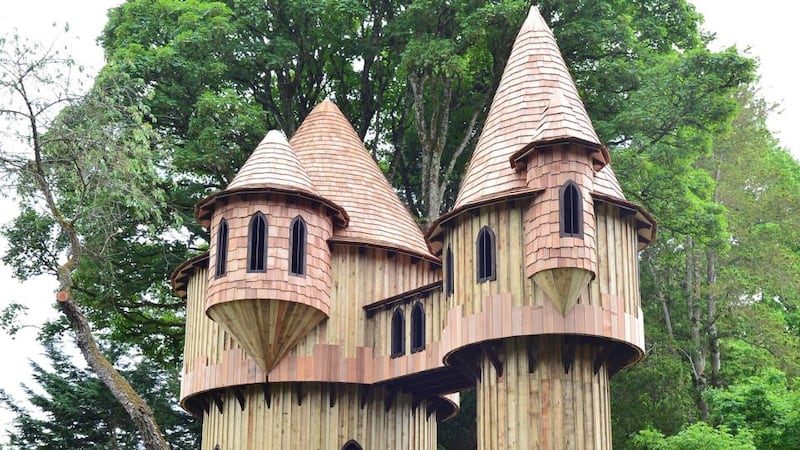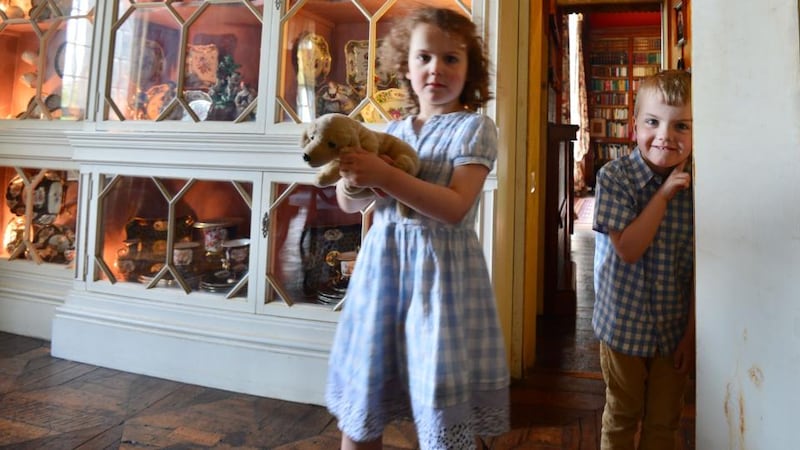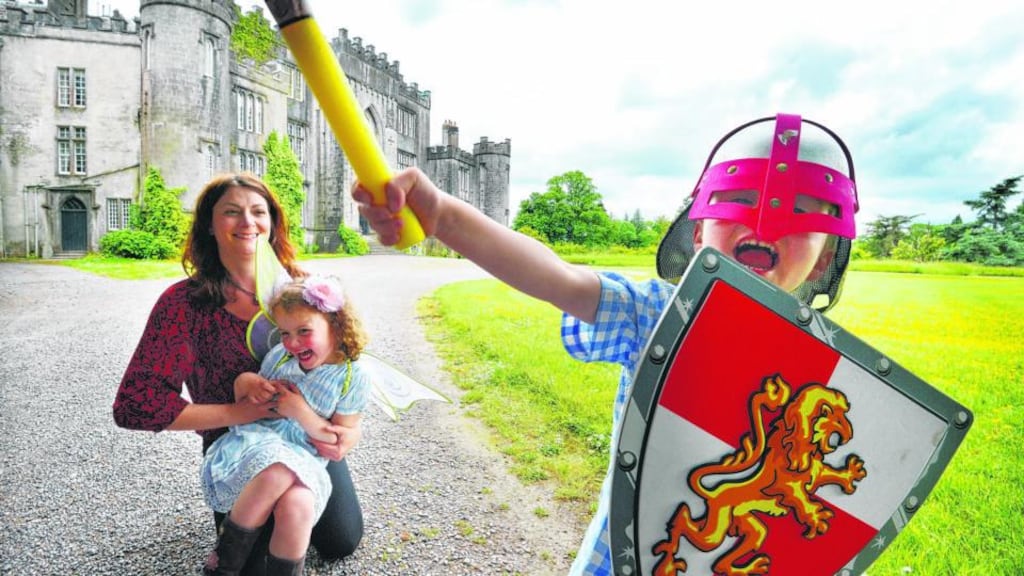Climbing the steep ladder into the giant treehouse at Birr Castle Demesne in Co Offaly I get a tingling in my stomach. It's not the height of the treehouse – which is at 14m – but rather an overwhelming sense of nostalgia and adventure: I'm transported back to childhood in this Rapunzel-esque structure.
“Go on – have a bounce!” says Lady Alicia Clements of Birr Castle. Bouncing on giant pillows in public is not normally my strong point but who can resist leaping on a pillow the size of most people’s lawn?
Besides there’s something about Alicia’s relaxed yet decisive tone which both invites you in and simultaneously suggests her as the type of woman who gets things done.


The €200,000 tree house was financed by the Birr Foundation and Offaly Local Development Company, a State-funded organisation that supports projects designed to make Offaly “a better place to live” by enhancing community life and developing enterprise. Birr Castle has also benefitted from on-going support from Fáilte Ireland.
The tree house It has the romantic shape of fairytale castles with round turrets and will have an insignia flying from the top, emblazoned with the family crest of three leopards.
Great care has been taken in its positioning – it nestles between a giant redwood and a chestnut tree and the seventh Earl of Rosse, known as Brendan, Alicia’s father, has been keeping a close eye on proceedings in relation to his trees.
There is a rope bridge, an extra-long fireman’s pole, a huge slide, plenty of nooks and crannies, to hide in, and Gothic-style windows to peep out of from a height.
The tree house and bouncing pillow are the crowning glories of the new playground on the site of former tennis courts to the rear of the old stable buildings.
There’s a “banqueting hall” – a covered long table and benches made by slicing a tree felled on the demesne.
There are sandpits, open play areas and a “Hobbit Hole”, or den, built into the side of the embankment.
As mother to four-year-old twins Charlotte and Henry, Alicia knew that in order to make Birr Castle a great destination for families, it needed to cater more to children. For her, it is about “adapting to how society is going and recognising that change needs to be ongoing”.
Change and innovation have been features at Birr Castle since 1620. The family claims to have had electricity before London and Dublin.
For 75 years the site was home to the largest telescope in the world, built by William Parsons, the third Earl of Rosse in the 1840s, while his son made many discoveries, such as predicting the temperature of the surface of the moon – calculations which would be confirmed years later.
In the science galleries at the castle a note from Neil Armstrong reads: “With all good wishes and appreciation for the contributions of an astronomical family. Apollo 11.”
Another ancestor, Charles Parsons, invented the steam turbine in 1884 which transformed transport and electricity production. He and a brother created a steam car from which a cousin, Mary Ward, fell from and died in the first recorded fatality involving a powered car.
Yet another relative, Lady Mary Rosse, was an early adopter of photography and many of her negatives from the 1850s survive at the castle. Her darkroom is thought to be the oldest one in the world.
Alicia lives with her husband Nathaniel Clements and the twins on an estate about a mile down the road, her brother Patrick, Lord Oxmantown, lives with his parents Lord and Lady Rosse at Birr Castle with his wife Anna Lin from Tianjin in China and their two children Olivia (seven) and William (five).
Another brother, Michael, has just returned from Cambodia and is renovating some buildings beside the castle which would, in the past, have supplied everything necessary for the running of the household.
Alicia rejects the notion that being heir to a large estate can be challenging. “It’s only a burden if you make it a burden,” she says. “We have the option to leave, but we all love the place so much. We all went and did our own things, but we are all coming back because we love it and we are lucky that our parents are very encouraging and supportive. They’re delighted that, firstly, they’ve got children and, secondly, they’ve got children who love the place and want to keep it.”
Rather than open up the castle as a hotel or wedding venue, the family has kept it as a private residence though they do run tours in some summer months and welcome visitors with specialist interests who wish to do research. “The reason we don’t do tours in the afternoons is that the children tend to be around more then,” says Alicia. “You can’t tell the children to be quiet or to stay upstairs!”
The castle, built of local limestone, has had structures such as towers and halls added over time. The family motto on the imposing front door reads, in Latin: “For god and king” but it has since been changed to: “For god and the stars.”
The castle interior is imposing yet, unlike great houses that have been turned into visitor centres, it has a warmth that hints to its inhabited state. It’s a lived-in house certainly, but how many ordinary homes have original busts of Queen Victoria (with her real hair) in the drawing room or solid yew staircases dating from the 1600s?
Tapestries, carpets, furniture and antiques from every period and style blend in a glorious concoction that is, at times, foreboding and, at times, pure confection and fun: in the hall there are the cannonballs that were blasted at the castle in a siege in 1688; the salon contains antique harps and pianos, and ancestors’ wedding photos. In the drawing room is a doorway hidden in a china cabinet.
The castle has over 100 rooms. “Though it depends what you call a room,” says Alicia.
“It’s true that it is a huge luxury of a home and you have to live in all of it in order to maintain it – if you don’t live in some of the rooms you can be unaware when damp is striking.”
She is out of breath when she returns from running upstairs to the nursery.
The main attraction at Birr Castle is the gardens which are the largest open to the public in Ireland and cover an impressive 120 acres (50 hectares).
The gardens are twinned with those at Nymans in Sussex, England, a National Trust garden and home of the Brendan’s mother, Anne Messel, Countess of Rosse. Another son is Lord Snowdon, from her marriage to Ronald Armstrong-Jones .
On the day we visited, Lord and Lady Rosse were accompanying BBC filmmakers around the gardens.
While Alicia shows us around the house, her father Brendan proudly tells us of his garden's inclusion the Great Gardens of Europe book alongside those of Hampton Court and Versailles.
The gardens at Birr include two rivers, a lake and about 3,860 varieties of trees from over 40 countries.
Lord Rosse tells me he has a passion for trees from China, specifically the southwest of the country, which, he says, has a climate not dissimilar to ours.
He shows us documentation that the estate also includes a large proportion of Champion Trees – those with the widest girths and heights, such as the giant sequoia and the grey poplar.
In its heyday the estate employed 16 gardeners, now there are four. It attracts over 100,000 visitors a year, including local residents who walk the environs of the castle often, and visitors to the country fair each August.
Despite the changing interests of its inhabitants, Birr Castle has remained a family home and one much loved by its inhabitants. “There’s a real difference between running a place as a commercial enterprise and running it as we do, because we love it,” says Alicia.
“What we have found is that the next generation has very different interests than the one before but they complement each other and therefore each generation manages to change the direction taken.”
The tree house and playground at Birr Castle opens on Monday. Entry is included in the overall admission cost to Birr Castle Demesne of €9 for adults, €5 for children and €25 for families. See birrcastle.com

















